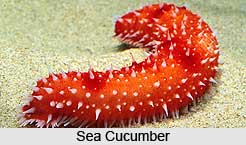 Sea Cucumbers are tough skinned, sausage-shaped echinoderms, in shape and architecture entirely different from the starfish and sea-urchin. They live buried in sand or under rocks below low-tide mark and also in deep water. They are plentiful in the Pacific Ocean and Indian waters. In size they range between six centimetres to two meters and more. The body of a sea cucumber is roughly cylindrical and in some cases long and five-sided, not unlike that of a cucumber. Protruding from the mouth at the anterior end is a circlet of feathery retractive tentacles which are actually modified tube-feet. At the posterior end is the anus.
Sea Cucumbers are tough skinned, sausage-shaped echinoderms, in shape and architecture entirely different from the starfish and sea-urchin. They live buried in sand or under rocks below low-tide mark and also in deep water. They are plentiful in the Pacific Ocean and Indian waters. In size they range between six centimetres to two meters and more. The body of a sea cucumber is roughly cylindrical and in some cases long and five-sided, not unlike that of a cucumber. Protruding from the mouth at the anterior end is a circlet of feathery retractive tentacles which are actually modified tube-feet. At the posterior end is the anus.
The body of the Sea Cucumber is soft and fleshy within, five-sided and covered by a thick transparent skin which has strong muscles enabling the animal to shrink and expand move forwards. When it moves, a number of tube-feet with suckers protrude along the five sides and they aid locomotion. In those species lying parallel to the sandy surface a definite dorsal and ventral side can be recognized and in such species the tube-feet are confined to the ventral side only. Some species have sharp spicules embedded in the flesh. These are defensive and also assist in locomotion. Members of the genus Synapta have no tube-feet at all but a number of specialized spines with which they can successfully anchor to any soft body. Some live in the open sea and can float and swim propelled by the tentacles.
The ability of a Sea Cucumbers to contract and escape from their enemies is marvellous. At the slightest probability of an attack they squirt out water, shrink to an insignificant mass and recede into a hole in the rock.
The alimentary canal of a sea cucumber consists of a mouth, a cylindrical throat, a short gullet, a small muscular stomach and a very long, looped intestine ending in an anus. The food consists of organic matter existing in the sand and mud in the sea bottom. Some species also feed on small sea organisms caught in their frill-like tentacles. Sea cucumbers have great power of regenerating body parts. Cases have been recorded where sea cucumbers which lost their tentacles, intestines and other organs have developed these parts again in two months. Some large sea cucumbers are eaten by man, for example the beche-de-mer or sea slug.



















